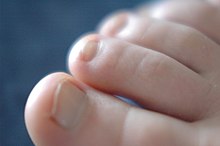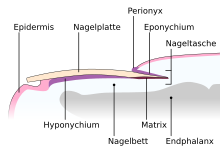Nail (anatomy)
In primates, a nail ( Latin unguis ) is a curved, translucent keratin plate on the top of the tip of the finger or toe , which on the one hand protects the fingertips and on the other hand supports the gripping function.
The equivalents to the nail in the animal world are called claws , hooves or claws . The adjective periungual means around a fingernail or toenail or around the nail , and subungual means under the nail , i.e. in the area of the nail bed or below.
Description and function
The nails (also known as nail plates) are descendants of the epidermis that only occur in primates in the form shown here. They form at the root of the nail from horn plates . The nail root is at the bottom of the nail pocket. The epithelium that lies in the nail pocket dorsal to the nail plate is called the eponychium; the epithelium under the nail (on which the nail rests dorsally) as hyponychium. Under the hyponychium lies the connective tissue nail bed, which is firmly attached to the periosteum of the terminal phalanx . Distally closes the hyponychium with the Nagelsaum from. In the area of the nail root, the hyponychium becomes the matrix, it forms the substance of the nail plate - the corresponding area is also recognizable as the nail lunula. The nails are laterally surrounded by a fold of skin, the so-called nail wall. Perionychium or perionyx ( German cuticle ) is the name given to the visible part of the skin lying directly on the nail wall dorsal to the nail plate.
Considered mechanically nails provide an abutment for the sensitive fingertips (in animals "tactile clench "). They are the nail bed (matrix or Matrixepithel) and are connected sufficiently firmly with this to be an effective scratch, scratch and Zupfwerkzeug can be used. How important the nail is for these functions can also be seen from the dense, sensitive innervation in the mainly anterior area (3–4 mm) of the epidermis. Where the fingertip skin reaches under the nail, a sensory cell border records the tactile (i.e. tactile) information of the almost immobile nail plate. Just by touching an object with the nail, surface properties and hardness can be determined, which would otherwise not be possible. The area of the hyponychium is almost numb, but touching it without a nail is painful.
Nail formation and growth
Nails consist of 100 to 150 irregularly stacked layers of horny cells and are usually between 0.05 (a baby's nail) and 0.75 mm thick. The nail formation ( onychization ) is a keratinization deep behind the nail fold without the formation of the intermediate stage keratohyalin . The different nails grow at different speeds, around 0.5–1.2 mm per week. In the case of human nails, that of the middle finger usually grows the fastest. A delay in nail growth occurs in old age, with trauma and certain pathological processes.
Nail fold
The nail fold ( syn. Nail wall ) is the section of the skin that includes the fingernails and toenails on the side and at the root. This raised skin covers the invisible part of the nail and gives it hold. The nail wall also serves as protection against painful tears.
Diseases and injuries

As a rule of thumb , if a disorder affects the nail matrix , the nail lesion will grow. If it affects the nail bed, it is a permanent lesion . Finger and toenails can be harmed by a number of diseases . One of the problems most frequently described and almost exclusively by women concerns the nails that are too soft and brittle: The reasons for this symptom, as far as is known, have not yet been scientifically researched. However, it can be assumed that chemical nail polish removers promote or cause brittleness. A hereditary predisposition may be responsible for the brittleness.
Brittle and splintering nails can be signs of a lack of biotin (vitamin H). Biotin is essential for the formation of the horny substance keratin and thus contributes significantly to the healthy growth of skin , hair and fingernails.
Skin or nail injuries (among other things) can lead to an attack by nail fungus ( nail mycosis ), which affects the color and shape of the nails. Treatment of the slowly growing toenails, for example, is tedious. Many systemic diseases also left signs on the nails, such as the psoriasis ( psoriasis ). As characteristic changes, it leaves spotted nails and oil stains and in extreme cases crumbly nails as a sign of complete nail dystrophy .
Longitudinal grooves on the fingernails are usually a normal symptom of aging, which appear from the age of 35 at the latest. Transverse grooves usually arise when growth slows down during an illness (e.g. infection with a high fever).
Injuries to the nail bed, for example from being trapped in a door or the like, usually remain visible for a lifetime. Damage from excessive use or stress (for example from long-distance runs) grows out again if there is enough time. If there is not enough time for healing, the nail root is permanently irreparably damaged and the nail falls off.
If the fingernails are strongly arched upwards and thereby more round than oblong, one speaks of " watch glass fingernails ".
Inflammation of the nail fold is called paronychia , it can develop into a panaritium .
White spots
The white spots in the nail are a lack of fusion of the nail plates, which appear milky-white due to the changed light reflection (similar to the lunula). The intact nail surface, on the other hand, reflects the light in a more concentrated manner due to its almost smooth structure, which makes the nails look slightly reflective. The lack of fusion has many different causes, for example it is caused by a shock or also by illnesses or medication. The widespread view that white spots or spots on fingernails (leukonychia punctata) are signs of a protein deficiency or caused by calcium or magnesium deficiency has not been scientifically proven.
agnail
A hangnail or envy nail (according to the Dutch nijdnagel "neidnagel"; according to the popular belief that a hangnail is created when you are struck by an envious look) is a detached, but still tight, narrow strip of skin on the side of the nails. This can tear painfully and occasionally cause inflammation. To prevent this, the hangnail should be cut as close as possible to the base with disinfected scissors. The hangnail is (under reference to rivet / ache within the meaning of press) also Nietnagel called.
Chewing finger nails
A common expression of nervousness in humans is the chewing of the protruding parts of the fingernails and the cuticle (eponychium) , see onychophagia .
Fingernail test
In rescue medicine, among other things , the fingernail test is a method for orientating the peripheral blood flow situation, which allows a rough conclusion about the circulatory situation, especially if there is little time to examine every injured person, for example in the event of disasters and accidents. The nail is briefly pressed into the nail bed so that it turns white. If it takes longer than a second to recolor, there is insufficient blood flow. However, previous nail injuries can falsify this result.
Material tests are also known as fingernail tests. Either the nail is pressed into the material and then attention is paid to deformations or the like, or the tester moves the nail over the surface in order to determine the roughness depth using a reference standard .
The fingernail test should not be confused with the proverbial nail test .
maintenance
The care of the fingernails and toenails is called a manicure or pedicure . When filing the nails, care should be taken not to file over the edge to prevent the nail from fraying. Various nail care products are available in stores.
Society and culture
In China during the Qing Dynasty, the wearer showed with long fingernails that he did not have to do any physical work. This is still common in some countries in Asia and Africa (Egypt), where often only the nail of the little finger is left uncut.
Guitarists generally keep the nails of the grip hand short, while those of the strike hand (usually the right hand) grow longer. This is especially true for concert guitarists who play without a pick . Violinists can play their instrument best when the left hand nails are short.
In German, the phrase “ burn on your nails ” means that something is very urgent for someone. It possibly originates from the fact that the monks fixed a small candle on a thumbnail while praying or reading at night and, towards the end of the reading, ran out of time because the nails burned .
See also
- Unguis incarnatus - ingrown nail
- Toenail prosthetics
- Mees nail bands
- nail polish
- Nail modeling
- Onychauxis
- Beau lines
literature
- Hansotto Zaun, Dorothee Dill-Müller: Pathological changes in the nail . Spitta, 2004, ISBN 3-934211-69-0 .
Web links
Individual evidence
- ↑ Adolf Faller, Michael Schünke: The human body. 15th edition. Thieme Verlag, Stuttgart 2008, p. 764 f.
- ↑ a b c R. Bertolini among others: Systematic anatomy of humans . Fischer, 1982, ISBN 3-437-00375-5 , pp. 586-587 .
- ↑ Ian J. Alexander: The foot. Examination and diagnostics . Springer, 1990, ISBN 3-540-53820-8 , pp. 19 ff (Original title: The foot . Translated by Arnd Herz, English).
- ^ Helga Fritsch, Helmut Leonhardt: Taschenatlas Anatomie, Georg Thieme Verlag , 10th edition, 2009, ISBN 3-134-92110-3 , Volume 2, p. 434. Online
- ↑ Peter Reuter: Springer Lexicon Medicine. Springer, Berlin a. a. 2004, ISBN 3-540-20412-1 , p. 1667.
- ↑ Helmut Leonhardt: Histology, cytology and microanatomy of humans. Paperback of the entire anatomy. Thieme, Stuttgart 1985, ISBN 3-13-371507-0 , pp. 314-315.
- ↑ The middle finger nail is the fastest (archive.org from October 19, 2016) .
- ↑ Hansotto Zaun, Dorothee Dill-Müller: Pathological changes in the nail. 9th edition. Spitta Verlag, 2004, ISBN 3-934211-69-0 , p. 11.
- ↑ Drösser: White spots on the fingernails indicate a calcium deficiency . In: The time . No. 12 , 1999.
- ↑ Remove rivet nail (actually Niednagel) , report in the online edition of Freund (magazine) (freundin.de)
- ^ Friedrich Kluge , Alfred Götze : Etymological dictionary of the German language . 20th ed., Ed. by Walther Mitzka , De Gruyter, Berlin / New York 1967; Reprint (“21st unchanged edition”) ibid 1975, ISBN 3-11-005709-3 , p. 506 ( Neidnagel ).




